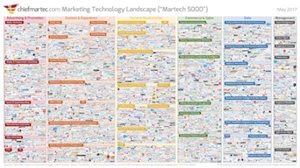Martech Thought Leader to Lead HubSpot’s Platform Ecosystem
If you are familiar with this iconic marketing technology landscape graph, you may already  know who Scott Brinker is as he is the creator and editor of this long-running martech landscape. If this still didn’t ring a bell, then, you may remember him from chiefmartec.com or the MarTech conference as he publishes the Chief Marketing Technology blog at chiefmartec.com and he is also the program chair of the MarTech conference, the vendor-agnostic event series focused on the intersection of marketing, technology, and management. However, the reason he has made headlines is not due to his on-going roles mentioned but because of his new position as he has recently been appointed as HubSpot’s Vice-President, Platform Ecosystems.
know who Scott Brinker is as he is the creator and editor of this long-running martech landscape. If this still didn’t ring a bell, then, you may remember him from chiefmartec.com or the MarTech conference as he publishes the Chief Marketing Technology blog at chiefmartec.com and he is also the program chair of the MarTech conference, the vendor-agnostic event series focused on the intersection of marketing, technology, and management. However, the reason he has made headlines is not due to his on-going roles mentioned but because of his new position as he has recently been appointed as HubSpot’s Vice-President, Platform Ecosystems.
Before joining HubSpot, Scott was the co-founder and CTO of ion interactive, a provider of  interactive content marketing software to many of the world’s leading brands. Commenting on how the event unfolded in his blog post: ”I wasn’t planning to take a new job. I was very happy as the CTO of ion interactive working on the future of interactive content. While I was flattered whenever other firms reached out, my mission at ion still stirred my passion more,” said Brinker. “But then HubSpot approached me about the opportunity to help them shape their platform ecosystem strategy. Frankly, it was one of those “you had me at hello” moments.”
interactive content marketing software to many of the world’s leading brands. Commenting on how the event unfolded in his blog post: ”I wasn’t planning to take a new job. I was very happy as the CTO of ion interactive working on the future of interactive content. While I was flattered whenever other firms reached out, my mission at ion still stirred my passion more,” said Brinker. “But then HubSpot approached me about the opportunity to help them shape their platform ecosystem strategy. Frankly, it was one of those “you had me at hello” moments.”
What Does This Move Mean To You?
Digital innovation is driving the move to bring together the organization's own systems and contributions from outsourcers and "as a service" providers. As many recent studies back it up, more and more marketers remain committed to a best-of-breed approach to vendor selection rather than seeking the advantages of single-source solutions. Additionally, Gartner stated that of the 123 references surveyed for its Magic Quadrant, 88 percent reported integrations with at least one hub product other than the one by which they were referred. So, obviously, the vendors that offer the most connections have the upper hand in the competition game.
To satiate this obvious interest, digital platforms underpin the creation of new business models by integrating ecosystems of people, business, and things. This is, unfortunately, easier said than done as organizations need a paradigm shift in perspective, away from the traditional supply-demand economic perspective.
The concept of network externality is nothing new, yet it goes back over a century. Between 1885 and 1889, Theodore Vail, president of American Telephone & Telegraph, utilized the power of network effects to build a monopoly on US telephone service. By 1908, he had signed up over 4.000 local and regional carriers. By 1995, the concept had matured and Robert Metcalfe, co-inventor of the Internet, popularized the term network effect. Today’s concept of increasing interconnection, making it easy and quick to connect everything is the result of this century-long effort.
Even though it creates the large potential for value and profitability, the configuration of platform ecosystem is one of the key tasks in a platform economy. Developing a win-win-win model that is beneficial for all platform ecosystem actors may represent a huge challenge and requires a strong commitment.
As having the largest market share in the marketing automation landscape, HubSpot’s move to appoint one of the most influential CTOs in the industry as VP of Platform Ecosystems justifies this emerging platform ecosystem trend and proves that the concept of creating a business ecosystem will become a mainstream in the upcoming years.
Where does HubSpot Sit in This Shift?
As the B2B platform ecosystem is on the cusp of a complete transformation, Scott Brinker believes that HubSpot has the right vision and positioning to lead that change. In Brinker’s own words: “Having the CEO firmly behind a platform mission is essential. But as I talked with more of HubSpot’s team, it was inspiring to see how deeply platform-thinking was already flourishing throughout their organization.” He claims that HubSpot is genuinely committed to fostering a world-class platform ecosystem. His hire came at a time when HubSpot’s Connect Partner Program has grown to over 100 integration with new partners such as AdEspresso by Hootsuite, Terminus, AdRoll, and Brightcove. In his new role, Brinker will be tasked with growing and nurturing HubSpot’s technology partner community.
If we look at HubSpot’s partner pledge, it is so hard not to agree with Scott Brinker. In the pledge, some statements made by HubSpot’s chief strategy officer, Brad Coffey, speaks loudly for the vendor’s vision. To put this into context, here is a few direct quotes from the pledge:
-
We won’t take unfair advantage of our platform ownership simply because we want to sell more of our own stuff. This means not restricting public APIs or throttling specific integration partners. That wouldn't SFTC because it stifles innovation.
more of our own stuff. This means not restricting public APIs or throttling specific integration partners. That wouldn't SFTC because it stifles innovation.
-
We will do our best to let an integration partner know (under NDA) if we plan to enter a space they are in. We aren’t interested in blindsiding our partners. Not fun.
-
We will strive to develop an all-inclusive network for our integration partners that not only grants technical access, but marketing, community, and event access as well through our integration partner benefits. We won’t prevent integration partners from talking to each other or to other partners (i.e. Agency Partners) in our network -- in fact, we encourage it.
Animoto, an online video creation platform, is the most recent partner joining the HubSpot Connect Partner program. With this integration, HubSpot users now can create marketing videos with Animoto’s Marketing Video Builder and send them right back to HubSpot with one click. As a part of the new integration, Animoto has released three pre-built storyboards or video templates that can be customized with photos, video clips, and text. Those Storyboard video templates are designed to provide intuitive guidance to the everyday marketer and incorporate proven marketing best practices, with the underlying flexibility for businesses to make these videos their own, according to the Brad Jefferson, co-founder and CEO of Animoto.
Through its strategic partnerships and acquisitions, HubSpot is rapidly becoming a central player supporting an array of related sales and marketing software. Co-founder Dharmesh Shah alone has invested in more than 30 startups, including Apperian, InsightSquared, and Backupify. These investments are being made not only for beefing up the HubSpot ecosystem but also for acqui-hiring new talents. Given a talent gap, particularly in emerging technical fields, is an alarming threat for many organizations, HubSpot wants to plant the seeds so it can take advantage of the new talent pool.
My POV
In many industries, the key to innovation and efficiency is platform-based ecosystems as they are a fuel for innovation for many technologies, products, and services in the global economy. On the other hand, it is a daunting task to orchestrate the collaboration within the platform ecosystem. Therefore, the promises that HubSpot conveyed through its partner pledge are really what many technology providers need to follow. However, actions speak louder than words, so we'll see how many of those promises the vendor will live up to.
Scott’s hire and HubSpot’s pledge aside, while writing this article, I came to ponder about how organizations sustain control over the core and external components in the system. More importantly, is control really necessary to gain profit from the platform at all? In the upcoming days, I will strive to find the answers to these questions. Until then, why don’t you share your thoughts by either giving us a shout out on social media or simply typing in the comment section below?

Venus Tamturk
Venus is the Media Reporter for CMS-Connected, with one of her tasks to write thorough articles by creating the most up-to-date and engaging content using B2B digital marketing. She enjoys increasing brand equity and conversion through the strategic use of social media channels and integrated media marketing plans.